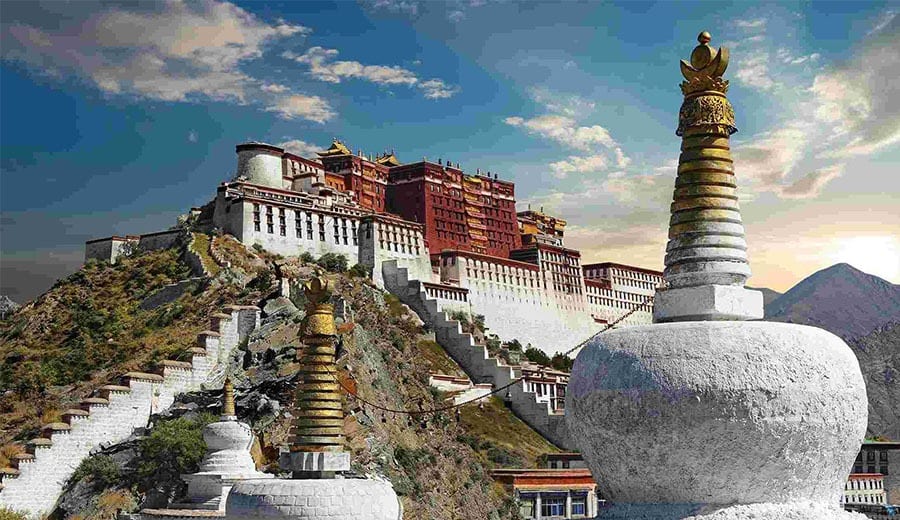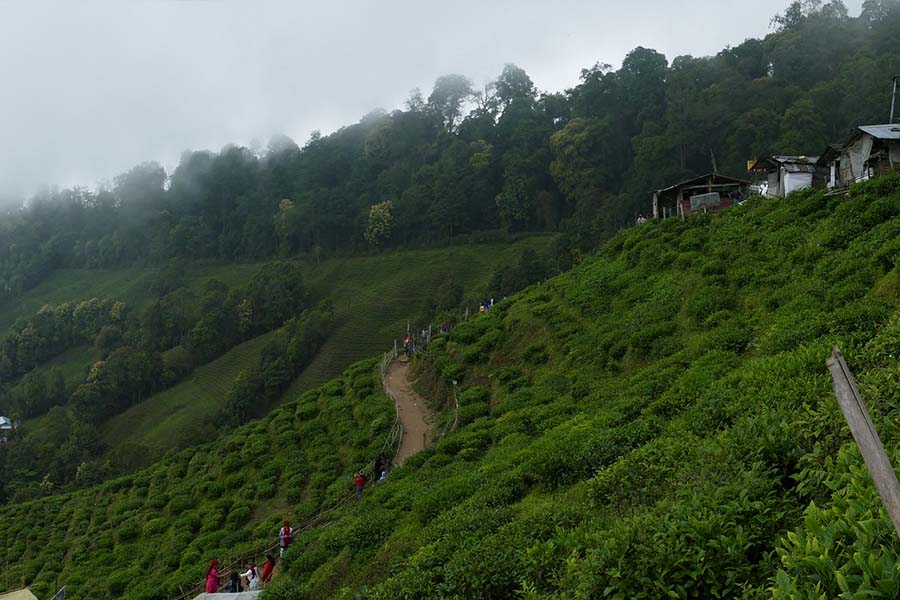Tibet Tourism
Facts to know about Tibet Tourism
Tourism in Tibet is a major industry, attracting visitors from all over the world to experience its unique culture, rich history, and breathtaking natural scenery. The Tibetan Plateau, also known as the “Roof of the World,” offers a variety of outdoor activities such as trekking, mountain climbing, and river rafting. Visitors can also visit historic landmarks, such as the Potala Palace and Jokhang Temple in Lhasa, and experience Tibetan culture through traditional festivals, art, and food. However, travelers should be aware that travel to Tibet is subject to certain restrictions and regulations imposed by the Chinese government.
Places to visit Tibet
1. Potala Palace:
The Potala Palace is a magnificent structure located in Lhasa, Tibet, and serves as a symbol of Tibetan culture and history. It was originally built in the 7th century and served as the winter residence of the Dalai Lamas. The palace sits on top of a hill and features over 1,000 rooms, chapels, and halls filled with valuable cultural artifacts and treasures. The main attraction of the palace is the White Palace, which contains the living quarters of the Dalai Lama, and the Red Palace, which serves as a place of worship. Visitors can also explore the various rooms and halls, each of which showcases the rich cultural and religious heritage of Tibet.
2. Jokhang Temple:
The Jokhang Temple is a sacred Tibetan Buddhist temple located in the heart of Lhasa. It is considered one of the holiest sites in Tibet and is said to have been built to house a statue of the Buddha that was brought to Tibet by the Chinese Princess Wencheng. The temple is a stunning example of Tibetan architecture and is adorned with intricate carvings, gold-plated roofs, and beautiful murals. Visitors can participate in traditional Tibetan Buddhist rituals and prayer sessions, as well as explore the temple’s many halls and chapels. The Jokhang Temple is also a UNESCO World Heritage Site and a popular destination for tourists visiting Tibet.
3. Mount Everest:
Mount Everest is the tallest mountain in the world and is located on the border of Nepal and Tibet. It is considered one of the ultimate challenges for mountain climbers and attracts adventurers from all over the world. The mountain is also a popular destination for trekkers who want to experience the breathtaking beauty of the Himalayas. Visitors can trek to the base camp, which is located at an altitude of 5,380 meters, or attempt to summit the peak. However, climbing Mount Everest is a dangerous and challenging task that requires proper preparation, equipment, and experience. Despite the risks, the experience of standing on the roof of the world is considered a once-in-a-lifetime experience for many.
4. Yamdrok Lake:
Yamdrok Lake is a large freshwater lake located in Tibet, known for its stunning turquoise blue waters and scenic beauty. The lake is surrounded by majestic mountains and is a popular destination for tourists who want to experience the beauty of Tibet’s natural landscapes. Visitors can take a scenic drive around the lake, go for a hike in the surrounding hills, or take a boat tour to get a closer look at the stunning scenery. Yamdrok Lake is also an important religious site for Tibetans, and it is said to be the home of several powerful spirits and deities.
5. Tashilhunpo Monastery:
Tashilhunpo Monastery is one of the largest and most important monasteries in Tibet and is located in Shigatse, the second-largest city in Tibet. The monastery was founded in the 15th century and was the traditional seat of the Panchen Lama, one of the most important figures in Tibetan Buddhism. Visitors can explore the various halls and chapels, which are adorned with beautiful murals, sculptures, and intricate carvings. The monastery also features a large statue of the Maitreya Buddha, which is considered one of the largest metal sculptures in the world. Tashilhunpo Monastery is a must-visit destination for anyone interested in Tibetan Buddhism and culture.
6. Lhasa:
Lhasa is the capital city of Tibet and is considered one of the most important cultural and spiritual centers in the world. The city is filled with ancient temples, monasteries, and palaces that showcase the rich history and culture of Tibet. Visitors can explore the Potala Palace, Jokhang Temple, and the Norbulingka Palace, which are all UNESCO World Heritage Sites. Lhasa is also a great place to experience Tibetan culture and cuisine, with many restaurants and street vendors offering traditional dishes and snacks. The city is also a hub for traditional Tibetan handicrafts, and visitors can find a variety of beautiful textiles, jewelry, and other items for sale in local markets and shops.
7. Namtso Lake:
Namtso Lake is one of the largest and highest-altitude saltwater lakes in the world, located in the Tibet Autonomous Region. The lake is surrounded by breathtaking mountains and is considered one of the most beautiful natural landscapes in Tibet. Visitors can take a scenic drive or hike to the lake, where they can enjoy the stunning scenery and take in the fresh mountain air. Namtso Lake is also an important religious site for Tibetans and is considered a sacred lake, with several monasteries and temples located nearby. Visitors can participate in traditional Tibetan prayer and meditation sessions, as well as visit the nearby hot springs, which are said to have healing properties.
8. Sera Monastery:
Sera Monastery is a historic Tibetan Buddhist monastery located in Lhasa, Tibet. The monastery was founded in the 15th century and was once one of the largest and most influential monasteries in Tibet. Visitors can explore the various halls and chapels, which are filled with beautiful sculptures, murals, and intricate carvings. The monastery is also famous for its daily debates, where novice monks engage in lively discussions about Buddhist philosophy and theology. Visitors can observe these debates, which provide a unique insight into the monastic life of Tibetan Buddhists.
9. Changtang Nature Reserve:
The Changtang Nature Reserve is a large protected area located in northern Tibet and is home to some of the world’s most spectacular natural landscapes. The reserve is home to several endangered species, including the Tibetan antelope, the snow leopard, and the wild yak. Visitors can take guided tours of the reserve and enjoy the breathtaking scenery, including vast grasslands, rolling hills, and snow-capped mountains. The reserve is also a popular destination for trekkers and adventurers, who can participate in activities such as horseback riding, camping, and wildlife watching. The Changtang Nature Reserve is a must-visit destination for anyone who loves nature and the great outdoors.
How to reach Tibet
Reaching Tibet can be done in several ways:
- By Air: The main airport in Tibet is Lhasa Gonggar Airport, which is located about 60 kilometers from the city of Lhasa. There are daily flights from several cities in China, including Beijing, Chengdu, and Xian. Visitors from outside China will need to fly into one of these cities before continuing on to Lhasa.
- By Train: The Qinghai-Tibet Railway is a high-altitude railway that connects Tibet with mainland China. The train journey from Beijing to Lhasa takes about 48 hours and offers stunning views of the Tibetan Plateau.
- By Road: Visitors can also reach Tibet by road, either by driving or taking a bus from mainland China. This is a popular option for those who want to take their time and enjoy the scenic journey. However, due to the high altitude and challenging road conditions, this route is not recommended for inexperienced drivers.
It’s important to note that visitors to Tibet are required to obtain a Tibet Travel Permit in advance. This permit can be obtained through a travel agency or directly from the Chinese government. Additionally, foreign travelers may be required to provide additional documentation, including a passport and a Chinese visa.
Best time to visit
The best time to visit Tibet depends on your interests and what you want to experience while you’re there. Generally speaking, the best time to visit Tibet is from April to October, when the weather is mild and sunny. During these months, the skies are clear, making it the ideal time for outdoor activities and sightseeing.
If you’re interested in trekking or exploring the natural landscapes of Tibet, the best time to visit is from June to September, when the temperatures are warm and the roads are clear. During this time, the wildflowers are in bloom, adding to the natural beauty of the region.
However, if you’re interested in visiting the monasteries and cultural sites in Lhasa and Shigatse, it’s best to avoid the peak tourist season from June to August, as the crowds can be overwhelming. Instead, consider visiting during the shoulder season in April and May or October and November, when the weather is still good and the crowds are smaller.
It’s important to note that the weather in Tibet can be unpredictable, with sudden changes in temperature and sudden storms, so it’s important to be prepared for a variety of conditions. Additionally, the high altitude of the region can cause altitude sickness in some individuals, so it’s important to take the necessary precautions and acclimate slowly.



